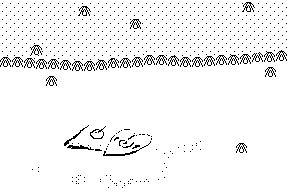This is an EL (Earth Language) experimental page to enjoy
the image of a haiku/short poem originally in English/Japanese.
When you can't see the Japanese parts,
please don't mind and just skip those parts.
地球語の文字や文字絵を用いて詩的表現や翻訳を試みる実験のページです。
Recently I'm also falling into writing haiku. Being still a beginner,
I started to feel like I had a long way to go. A haiku magazine
"Gin-yu" is going to take
some of my haiku, the editor, Natsuishi, told me, although I've never
seen the magazine yet.
Then I looked around some back number samples through the Internet;
and found this charming haiku in
issue 30 (April, 2006).
This original Japanese haiku was written by Tsengeg, when she was a student
learning Japanese at Soyol Eredem
University in Ulaanbaatar, Mongolia.
According to the chancellor of the university, Mongolia has about 2.5 million
people
in an area four times larger than Japan; and the winter temperature there
is sometimes
below -30 degrees centigrade. Tsengeg tried to write her inmost person's
name
in the middle of the endless white plain. The letters must soon be covered
by new snow.
But therefore the letters look fresher as if the sound of the name goes
off to the world.
In the pictograph, the character next to the indicator of "your name" turns
into "smile."
最近私自身も俳句にはまっています。まだ新米でめちゃくちゃですが、やってみると
どんどん深まるのでしょうね。雑誌『吟遊』
を私はまだ見たことがないのですが、
そこにいくらか採りあげていただくことになりました。
そこでウェブサイトの
「吟遊俳句ギャラリー推薦俳句1( 夏石番矢選)を
のぞき見ていたところ、第30号(2006年4月)で、ほほえましい句を見つけました。
これは、ウランバートルにあるモンゴル文化教育大学で日本語学習中だった
モンゴル女性のツェンゲグさんの俳句だそうです。彼女はもう卒業されたそうですが、
学長のソルイトさんが、「モンゴルは人口約250万人で、土地の面積は日本の4倍以上、
冬は寒くマイナス30度以下の場合もあります」とご案内くださいました。
果てしなく真っ白な平原に、彼女は心に秘めた人の名を書いてみました。
すぐまた新しい雪が降りつんですぐ消えてしまう文字。
だけどそれゆえに新鮮に、叫んでみたかのように、文字が迫ります・・
文字絵では、「あなたの名前」を示す印の次が「スマイル」しています。
 The original Japanese by Tsengeg:
The original Japanese by Tsengeg:
あの人の名を雪の上書いてみた
The English translation:
I tried
to write his name
on the snow
The EL translation:









The symbols in the pictograph:
 : snow (雪),
: snow (雪),  : smile
: smile
 {
{ bracket for classification,
bracket for classification, you}:
you}:
to show the following characters are for "your name" (次が「あなたの名前」と示す記号)
The symbols in the EL translation:
 {
{  d-verb mark,
d-verb mark, for the past tense} (過去動詞符)
for the past tense} (過去動詞符)
 {15recognition,21}:
try/trial, try (v. with gd)(試み)
{15recognition,21}:
try/trial, try (v. with gd)(試み)

 : tried something shown after
: tried something shown after  (~してみた)
(~してみた)
EL sometimes makes a sentence without the subject similarly to Japanese;
this translation follows to the original Japanese, omitting the subject
"I."
 : to show that the following character or phrase is an accusative case
of a d-verb (続く文字がD動詞の対格と示す)
: to show that the following character or phrase is an accusative case
of a d-verb (続く文字がD動詞の対格と示す)
 {
{ {
{ any language,
any language, shape}: visual symbols/notations,
shape}: visual symbols/notations, go}: writing, write (v, with gd)(書)
go}: writing, write (v, with gd)(書)
 (preposition mark): to show
the following character(s) modifies the front words (前置符)
(preposition mark): to show
the following character(s) modifies the front words (前置符)
 {20out/male,
{20out/male, to show pronouns}: he, his, him; here means "his" modifying the following
noun: name. (彼の)
to show pronouns}: he, his, him; here means "his" modifying the following
noun: name. (彼の)
 {
{ {
{ recognition,
recognition, abstract thing}: language,
abstract thing}: language, }: name (名前)
}: name (名前)
 {
{ preposition,
preposition, {
{ upper,
upper, surface} the upper surface}:
on (the upper surface of) (~の上面の(に)
surface} the upper surface}:
on (the upper surface of) (~の上面の(に)
 {
{ {
{ nature,
nature, water}:
rain,
water}:
rain,  solid}: snow
(雪)
solid}: snow
(雪)
To the top
 The original Japanese by Tsengeg:
The original Japanese by Tsengeg:



 {
{ bracket for classification,
bracket for classification, shape}: visual symbols/notations,
shape}: visual symbols/notations, go}: writing, write (v, with gd)(書)
go}: writing, write (v, with gd)(書) (preposition mark): to show
the following character(s) modifies the front words (前置符)
(preposition mark): to show
the following character(s) modifies the front words (前置符) {
{ abstract thing}: language,
abstract thing}: language, {
{ preposition,
preposition, {
{ upper,
upper, surface} the upper surface}:
on (the upper surface of) (~の上面の(に)
surface} the upper surface}:
on (the upper surface of) (~の上面の(に) {
{ water}:
rain,
water}:
rain,  solid}: snow
(雪)
solid}: snow
(雪)